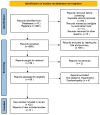Genetic Mutations and Mitochondrial Redox Signaling as Modulating Factors in Hypertrophic Cardiomyopathy: A Scoping Review
- PMID: 38892064
- PMCID: PMC11173352
- DOI: 10.3390/ijms25115855
Genetic Mutations and Mitochondrial Redox Signaling as Modulating Factors in Hypertrophic Cardiomyopathy: A Scoping Review
Abstract
Hypertrophic cardiomyopathy (HCM) is a heart condition characterized by cellular and metabolic dysfunction, with mitochondrial dysfunction playing a crucial role. Although the direct relationship between genetic mutations and mitochondrial dysfunction remains unclear, targeting mitochondrial dysfunction presents promising opportunities for treatment, as there are currently no effective treatments available for HCM. This review adhered to the Preferred Reporting Items for Systematic Reviews and Meta-Analysis Extension for Scoping Reviews guidelines. Searches were conducted in databases such as PubMed, Embase, and Scopus up to September 2023 using "MESH terms". Bibliographic references from pertinent articles were also included. Hypertrophic cardiomyopathy (HCM) is influenced by ionic homeostasis, cardiac tissue remodeling, metabolic balance, genetic mutations, reactive oxygen species regulation, and mitochondrial dysfunction. The latter is a common factor regardless of the cause and is linked to intracellular calcium handling, energetic and oxidative stress, and HCM-induced hypertrophy. Hypertrophic cardiomyopathy treatments focus on symptom management and complication prevention. Targeted therapeutic approaches, such as improving mitochondrial bioenergetics, are being explored. This includes coenzyme Q and elamipretide therapies and metabolic strategies like therapeutic ketosis. Understanding the biomolecular, genetic, and mitochondrial mechanisms underlying HCM is crucial for developing new therapeutic modalities.
Keywords: hypertrophic cardiomyopathy; metabolism; mitochondrial dysfunction; mitochondrial redox signaling.
Conflict of interest statement
The authors declare no conflicts of interest.
Figures






References
-
- Yokota T., Christiansen L.B., Dela F. Impaired mitochondrial oxidative phosphorylation and fatty acid oxidation with enhanced mitochondrial oxidative stress in spontaneously occurring feline hypertrophic cardiomyopathy. J. Card. Fail. 2014;20:S147. doi: 10.1016/j.cardfail.2014.07.098. - DOI
-
- Sequeira V., Waddingham M.T., Tsuchimochi H., Maack C., Pearson J.T. Mechano-energetic uncoupling in hypertrophic cardiomyopathy: Pathophysiological mechanisms and therapeutic opportunities. J. Mol. Cell. Cardiol. Plus. 2023;4:100036. doi: 10.1016/j.jmccpl.2023.100036. - DOI
Publication types
MeSH terms
Substances
LinkOut - more resources
Full Text Sources

